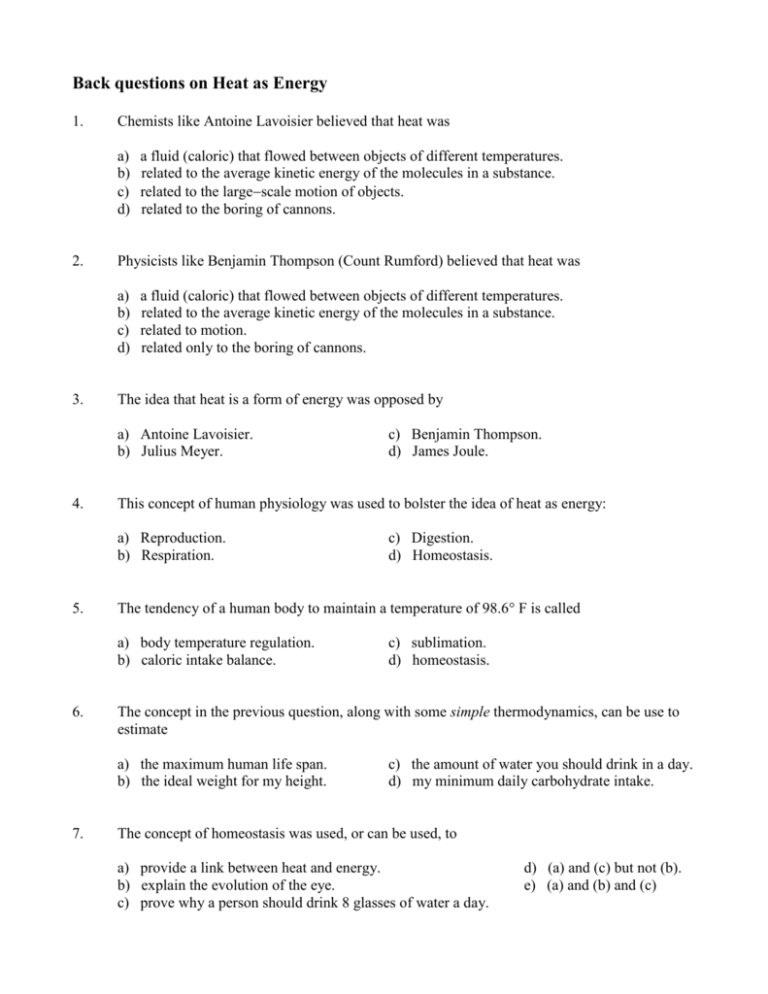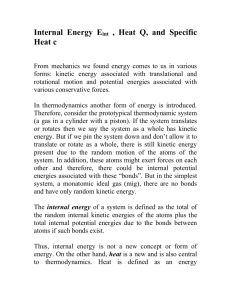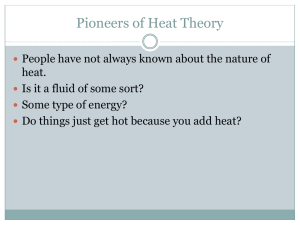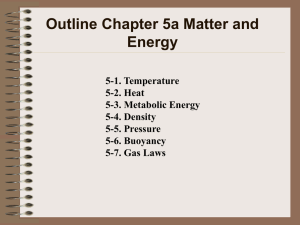Back questions on Heat as Energy
advertisement

Back questions on Heat as Energy 1. Chemists like Antoine Lavoisier believed that heat was a) b) c) d) 2. Physicists like Benjamin Thompson (Count Rumford) believed that heat was a) b) c) d) 3. a fluid (caloric) that flowed between objects of different temperatures. related to the average kinetic energy of the molecules in a substance. related to the largescale motion of objects. related to the boring of cannons. a fluid (caloric) that flowed between objects of different temperatures. related to the average kinetic energy of the molecules in a substance. related to motion. related only to the boring of cannons. The idea that heat is a form of energy was opposed by a) Antoine Lavoisier. b) Julius Meyer. 4. This concept of human physiology was used to bolster the idea of heat as energy: a) Reproduction. b) Respiration. 5. c) sublimation. d) homeostasis. The concept in the previous question, along with some simple thermodynamics, can be use to estimate a) the maximum human life span. b) the ideal weight for my height. 7. c) Digestion. d) Homeostasis. The tendency of a human body to maintain a temperature of 98.6 F is called a) body temperature regulation. b) caloric intake balance. 6. c) Benjamin Thompson. d) James Joule. c) the amount of water you should drink in a day. d) my minimum daily carbohydrate intake. The concept of homeostasis was used, or can be used, to a) provide a link between heat and energy. b) explain the evolution of the eye. c) prove why a person should drink 8 glasses of water a day. d) (a) and (c) but not (b). e) (a) and (b) and (c) 8. A physician, __________, used ___________ to support his hypothesis that heat was energy. a) b) c) d) 9. Hermann von Helmholtz . . . paddle wheels James Joule . . . paddle wheels James Joule . . . electric current Julius Meyer . . . observations of sick sailors Whose experiments firmly established the link between heat and energy? a) Julius Meyer b) James Joule 10. A measure of the average kinetic energy of the molecules in a substance is a) potential energy. b) temperature. 11. c) both (a) and (b). d) neither (a) nor (b). The Kelvin temperature scale is based on the freezing point of water (0 C) and a) water's boiling point. b) absolute zero. 14. c) Fahrenheit scale. d) Thompson scale. The total internal energy of an object is related to the a) object's temperature b) number of particles in the object. 13. c) the virial. d) Boltzmann's constant. A temperature scale based on the property mentioned in the previous question is the a) Celsius scale. b) Kelvin scale. 12. c) Hermann von Helmholtz d) Sadi Carnot c) frozen ammonium chloride. d) human body temperature. Assume that somehow (the third law of thermodynamics notwithstanding) a solid has reached absolute zero. We would then say that the solid’s molecules’ a) total kinetic energy is zero. b) average kinetic energy is zero. c) total gravitational potential energy is zero. d) (a) and (b) but not (c). e) (a) and (c) but not (b). 15. The boiling point of liquid nitrogen is 77 K. This is the same as a) 196C. b) 196F. 16. A gas at 200 K has twice as much internal energy as the same amount of the same gas at 100 K. a) True 17. b) False c) There is not enough information. Oxygen at 40C has twice as much internal energy as the same amount of oxygen at 20C. a) True 18. c) 135C. d) 107.6F. b) False c) There is not enough information. A gas at 20C has twice as much internal energy as a gas at 10C. a) True b) False c) There is not enough information. Answer Key: 1. A 2. C 3. A 4. D 5. D 6. C 7. D 8. D 9. B 10. B 11. B 12. C 13. B 14. D 15. A 16. A 17. B 18. C Typical short answer questions were on the handout that I distributed in class.




